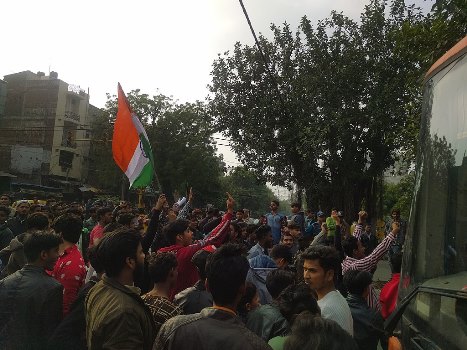This article was originally written for socialistworld.net, the website of the Committee for a Workers’ International.
In December 2019, the Modi-led BJP government imposed a new citizenship law that threatens the rights of millions of people in India. By introducing the CAA (Citizenship Amendment Act), the NPR (National Population Registry), and the NRC (National Register of Citizens), the Modi government is openly promoting India as a Hindu nation.
The new law singles out Muslims from certain countries as not eligible for citizenship while supposedly prioritising Hindus. In reality, most Hindus suffer horrendously under Prime Minister Modi’s regime of exploitation, privatisation and low pay, caste and women’s oppression. This has triggered huge anger among not just among religious minorities but from the wider population who have taken to the streets in huge numbers since the announcement to oppose this blatant violation of human rights. This state of agitation is not only because of the citizenship law but the continuous repression by the government.
The aggregated anger that has built up over the years has been unleashed in the northern state of Assam and quickly the mood transferred to other states. The demonetisation, implementation of an increased goods and services tax (GST), NEET(National Eligibility-cum Entrance Test-Under Graduate), the shutdown of democratic rights in Indian-occupied Kashmir, institutional killings, the Babar Mosque Verdict, etc., have all been part of the background to the outburst that is taking place now. The taking away of the national rights of the Kashmiris had already ignited national tensions in India which is a ‘prison-house’ of many nationalities. Now, this new offensive to assert ‘one nation’ on the Hindu agenda has provoked a mass movement.
A huge number of workers and young people are taking part in this mass movement to oppose the new citizenship act and the Modi regime. However, this is so far a cross-class movement. The movement has pushed some parties and individuals to act – including trying to and assume the leadership. This includes some of those pro-capitalist state parties who have not previously acted to defend workers and young people who have come out in opposition and called for mass protests. In the southern state of Kerala, which is led by the Communist Party of India (Marxist) (CPI (M)), the Chief Minister, Pinarayi Vijayan, stated that they will not implement the law. He has also written to 11 Non-BJP Chief ministers in other states asking them to demand a resolution in assembly similar to Kerala against the citizenship law. In addition to this, 100 different organisations have come together and formed a joint forum to carry out protests against the CAA law.
How the Modi government retaliates
In New Delhi, police entered the University campuses forcefully, and fired tear gas and beat the students holding anti-citizenship law posters. In Uttar Pradesh, the police targeted mainly poor Muslim families and asked them to pay for the damages caused by the CAA protests. People who participate in these protests, in any form, are either arrested or detained. The historian, Ramachandra Guha, was arrested and detained mid-interview. People who drew kolams (Rangoli) with anti-CAA slogans were detained in Tamil Nadu. There was a ban on demonstrations and a national level curfew was also imposed by the Modi government – which was however ignored by the protesters. People are still in the streets and not ready to give up.
The mass movements that have taken place across the world have also had an impact in India, particularly the movements in Chile and Hong Kong, where the masses have forced some concessions from what seemed strong governments.
The participation and radicalisation of students is also one of the important reasons why these CAA protests gained momentum in such a manner. This is the very first time since independence from British colonial rule that the entire nation had reacted to the repressions caused by the government.
It is a very crucial period for all the left organisations, especially the fighters within the communist parties, trade unions, farmers, students and working-class, to unite together to create a platform for struggle.
Not only the withdrawal of the CAA, NPR and NRC, but also other rights such as basic pay, freedom to practice any or no religion, the right to self-determination, refugee rights, free education and healthcare should be demanded. The upcoming general strike on 8 January 2020 can show the fighting masses their potential power. Tens of millions of workers are expected to take part in this strike which can shut down the whole country. This strike can be a start to build an alternative democratically organised platform that can offer a clear socialist alternative to capitalist policies.
The masses don’t have to wait for the parliament to deliver for them. Struggle committees can be built in workplaces, universities, etc., and can come together to form a powerful base to decide the future of the society. This is possible only through a coherent strategy to combine the opposition to the Modi regime with other demands such as decent housing, healthcare, education, land reform, religious rights, and an end to caste oppression, etc. Real change can only be achieved through the working class taking the power and carrying through the socialist transformation of society.
to read more – New Socialist Alternative (CWI India) leaflet text

